Gerard Ortín Castellví
Interview by Laura Plant
-
Published in August 2021
-

Installation view: Reserve at Funcació Joan Miró, Barcelona, 2017. Photograph Pere Pratdesaba.
Gerard, we met last year as part of the Horniman Museum x Artquest peer forum group, organised by Borbála Soós, which gathered to research what it means to think about rewilding in relation to a museum collection - locating the knowledge systems at work in these spaces and the manufacture of our gaze on the natural world. I wanted to know what the research group meant for you, especially since our meetings played out partly in the wake of this global pandemic?
Without having had time to process or understand the implications of the emerging pandemic I was, like many of us, already experiencing its effects on my body. I began to look for answers, opening multiple tabs in my browser, attending several online seminars, reading PDFs, listening to podcasts, etc. I remember how there was a sudden proliferation of essays, “Covid content” was being bombarded on social media while writers were trying to come up with the ultimate critical hypothesis about the virus —that would, in turn, strengthen their previous ideas. When we needed it most, knowledge production became commodified content consumption.
In that context, our meetings provided an alternative space to share and discuss ideas about contemporary ecologies, conservation, rewilding, etc., but also about how to situate ourselves in relation to such discussions and to the accelerated unfolding of a zoonotic pandemic. At that time I was also attending the Metabolic Rift reading group organised by Ros Gray, a series of monthly meetings around Ecologies and Alternatives, and another peer/research group called Border Ecologies. All these spaces helped me to situate myself and my practice in a moment of collective confusion and they’ve been informing my current research since then.
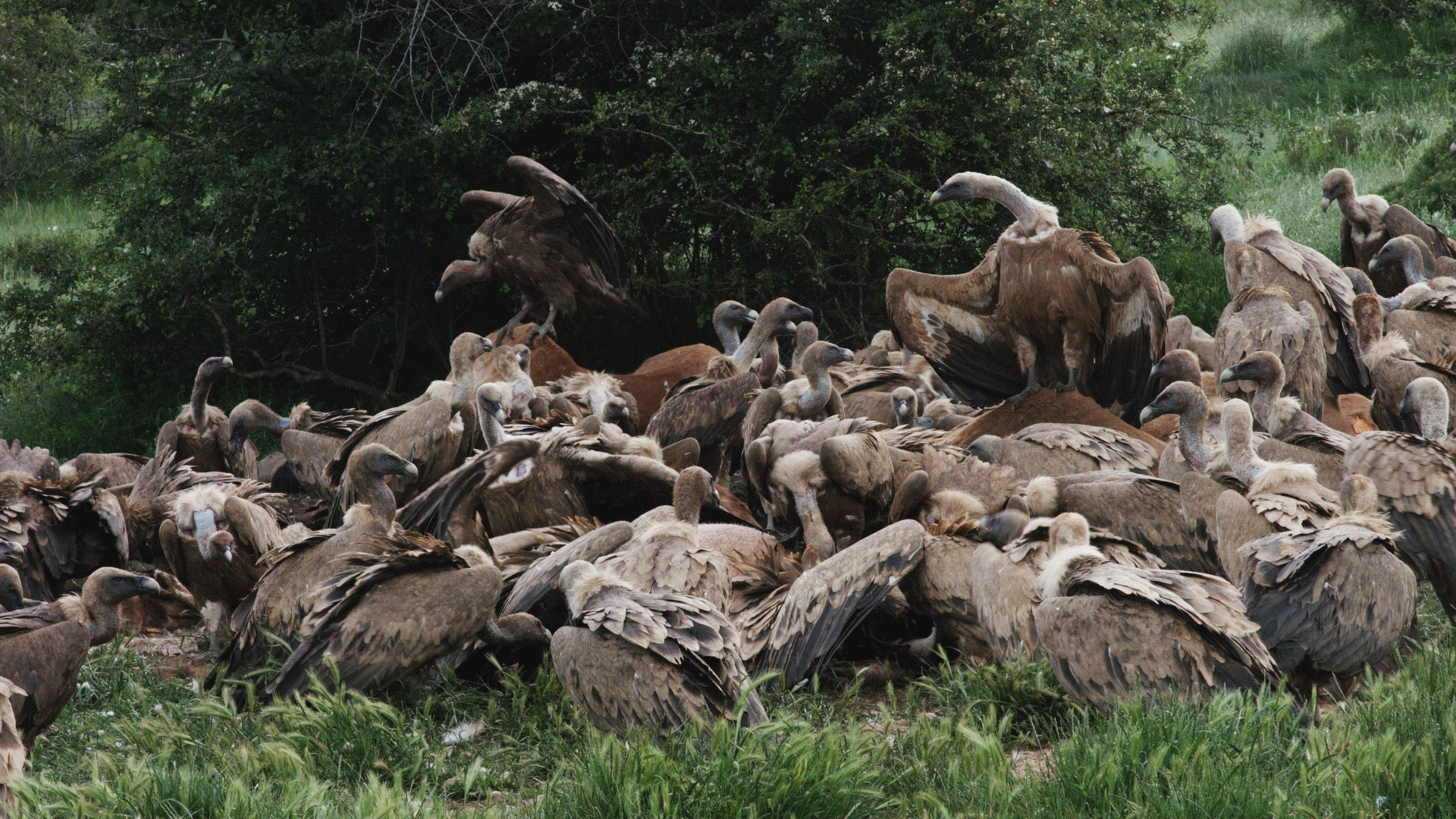
Still from the film Reserve (2020).
Yeah, I was completely overwhelmed by trying to formulate any kind of ‘response’ as an art worker, so the slow, contemplative approach in the Horniman group was a bit of a refuge… and for me held space for the weirdly compelling thought of the wildness we’d previously been discussing, suddenly being so uncomfortably present.
I feel a bit haunted by the image of the feeding vultures in your film Reserve, which signals one of a number of disturbances in a territory of the Basque Country, on which you have done lots of research. Can you talk a bit about this film and your interests in this landscape?
The film derives from an exhibition I did at Joan Miró Foundation (Barcelona), in 2017. Alexandra Laudo invited me to think about and with the idea of The Possibility of an Island, the title of her curatorial program. I suggested thinking about “reserves”, speculating about how —and to which extent— Protected Areas (PAs) could be understood as “islands” and what were the implications of applying such models of conservation. I’ve later on discovered a body of literature that attunes with our initial intuitions. Bram Büscher and Robert Fletcher, for instance, discuss how PAs have historically been conceived as isolated islands, contributing to create the so-called “fortress paradigm” in conservation. More often than not, such “fortresses'' end up requiring human intervention, since resources become scarce due to lack of genetic flow across park boundaries. Despite the deep conceptual and practical problematics of this model, it is recently coming back, spread by neo-protectionist advocates.

Still from the film Reserve (2020).
The scene that you describe was recorded at Valderejo Nature Park, the first PA in the Basque Country, inaugurated in 1992. It depicts a feeding station for griffon vultures –the largest colony of this species in the region. This PA has been suffering transformations over the years due to anthropogenic activity. Although Valderejo was never following a full “fortress-island” model of conservation, its species have been affected by the accelerated environmental changes of surrounding regions. The film explores one of them: the disappearance of wolves. And not only their disappearance but how their function in the ecosystem is replaced by a series of "wildlife management plans". One of the immediate consequences of the disappearance of keystone species is that the species that rely on their activity become endangered. Vultures are no exception to that and, like any scavenger bird, they usually eat from the carcasses of dead animals that are left behind by predators. In that area, where humans have been displacing wolves for years, a company is now hired by the local administration to collect dead animals from the surrounding farms, mostly due to natural deaths, and feed the vulnerable colony of griffon vultures.
Unfortunately, it’s not only the wolf's absence that makes human mediation necessary. After the BSE outbreak (also known as the “mad cow disease” outbreak) in the early nineties, it became mandatory to follow strict protocols for the management of dead cattle. Prior to the crisis, farmers around Valderejo would leave the carcasses of cows near their barns, to feed the vultures from the park. After the outbreak, these processes had to be regulated by law. A company was hired and the feeding was done following strict hygienic standards and sterilization protocols. It wasn’t a virus like COVID-19, but it was also a disease caused by a zoonotic spillover from non-human animals —cattle— to humans. In trying to produce cheaper meat, the capitalist food regime was feeding cows with MBM (meat and bone meal) creating a disturbance that reached a PA thousands of kilometers away from its origin in the UK. Almost 30 years later, we haven’t learned much from that and capitalist food regimes continue to have a disproportionate environmental impact.
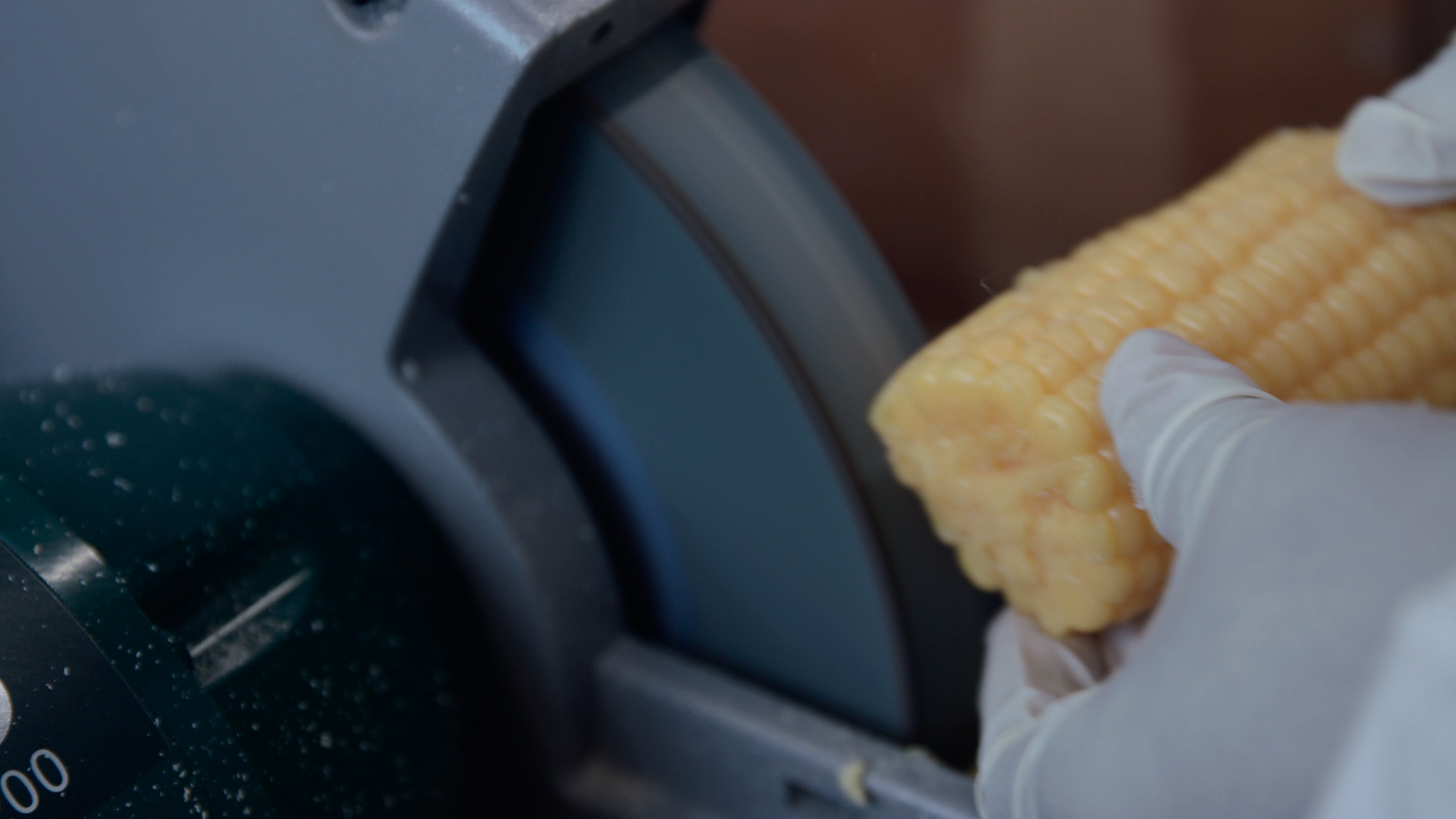
Still from the film Future Foods (2021)
I also found your research for this project about the synthetic wolf urine very interesting - a product manufactured in order to recreate the sensory territorial signals of the absent wolf, as a way of deterring wild boar, which would have previously been scared away by this predator and its smell. Another instance of us trying to fill in the gaps and attempting to harness a method of communication we can’t understand or is beyond the boundaries of our perception. Ideas about the construction of artificiality come into play in your work a lot, and I guess this links to your more recent Future Foods project and the ‘capitalist food regimes' you characterise in your current research. I’m interested in how you explore perception and image production in relation to these new food regimes... would you say this is related in some way to desire and the sensorial realm?
The wolf urine mentioned in Reserve is not exactly synthetic. Bare Ground Solutions, the american company that sells it, claims that it is “natural” and “100% Pure Meat Fed”. Nonetheless we could argue that the logistical apparatus that makes its extraction possible, the packaging and the global distribution, makes it somehow synthetic, or at least unhinged from its ecosystem. Through my practice, I try to challenge some of these notions, to question what we mean by ‘pure’ and ‘synthetic’, to problematize what it means to be ‘from’ an ecosystem. But I also try to look at the political implications of such notions and the hierarchies that stem from them, the power dynamics they generate. Sometimes, removing them from our vocabulary obscures these dynamics and hierarchies, and that is also problematic.
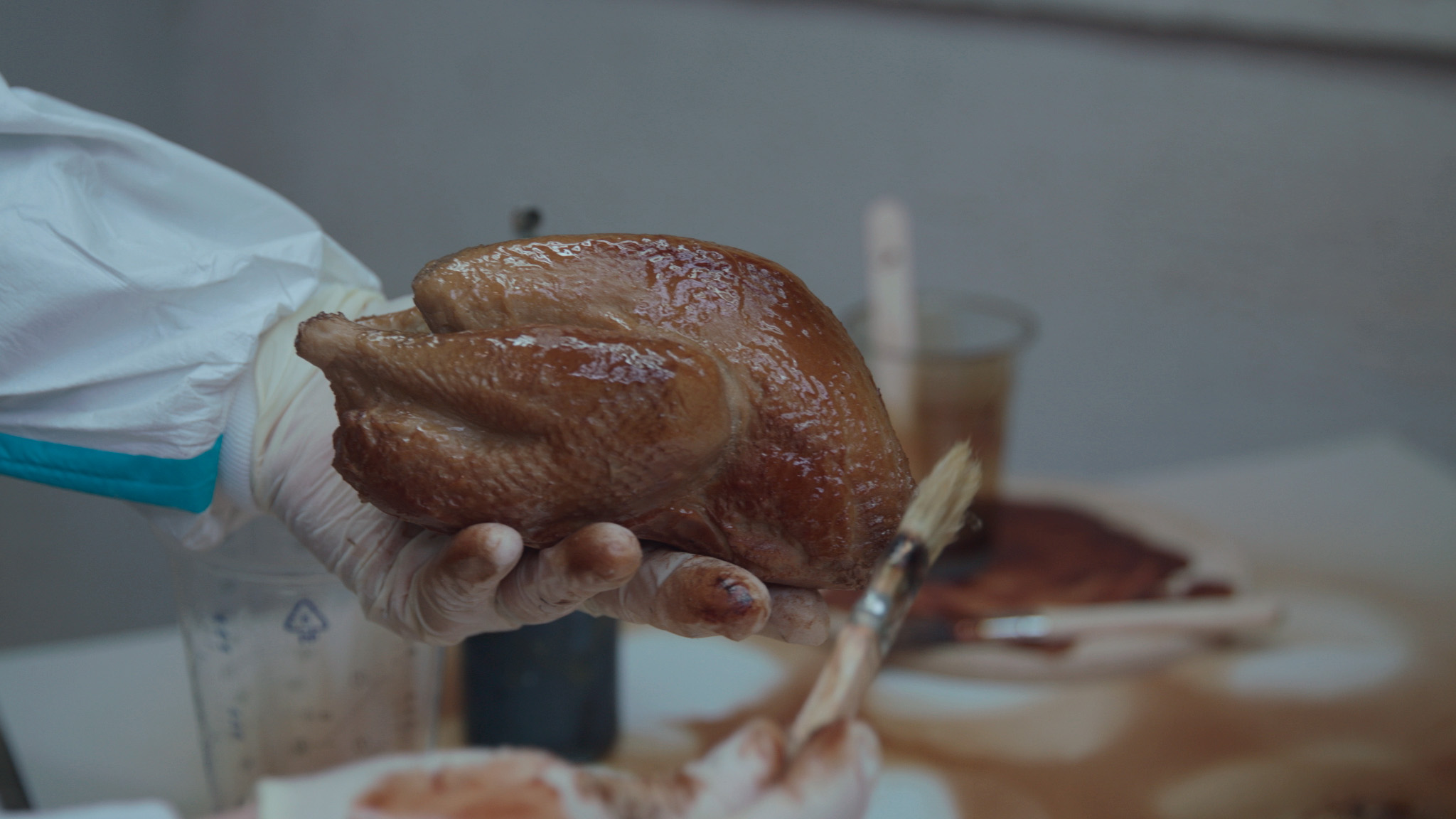
Still from the film Future Foods (2021)
I’ve been investigating the notion of a “food regime” coined in the 80’s by Harriet Friedman. It is a Marxist approach to theorise how food systems and agriculture have shaped capitalist economies —and vice versa. I am looking at the ways in which such regimes intersect visual and scopic regimes, regimes of visuality, aesthetic regimes that are concerned with image production, distribution and consumption. Thinking with Guattari’s idea of “mental ecology” —from the three ecologies, the one that is dealing with ecological “subjectivities”— we could speculate on how the very perception of food is tied to the metabolic chains that precede it —industrial but ecological as well. Hence, the ways in which we perceive food (from a shiny strawberry covered in melting chocolate, to a “green-gold” avocado toast or a juicy meat-free sausage made with palm oil) is directly linked to those chains: the territories where they are extracted from (Spain, Chile, Borneo) the humans and more-than-humans coexisting in those areas, and all the agents involved in the manufacturing processes to obtain them. As artists, we might not have the tools to address all the aspects of such complex systems without the help of political economists, anthropologists, human geographers, etc. But when it comes to the visual/perceptive regimes that support these systems, I believe we have some tools that we can put to work.
I think desire and the sensorial realm play a major role in contemporary food regimes. The gaze is not simply one end of a process of extraction and accumulation by dispossession. The gaze feeds those processes of extraction and dispossession through desire and the sensorial realm. Desire is not the problem, its instrumentalization is.
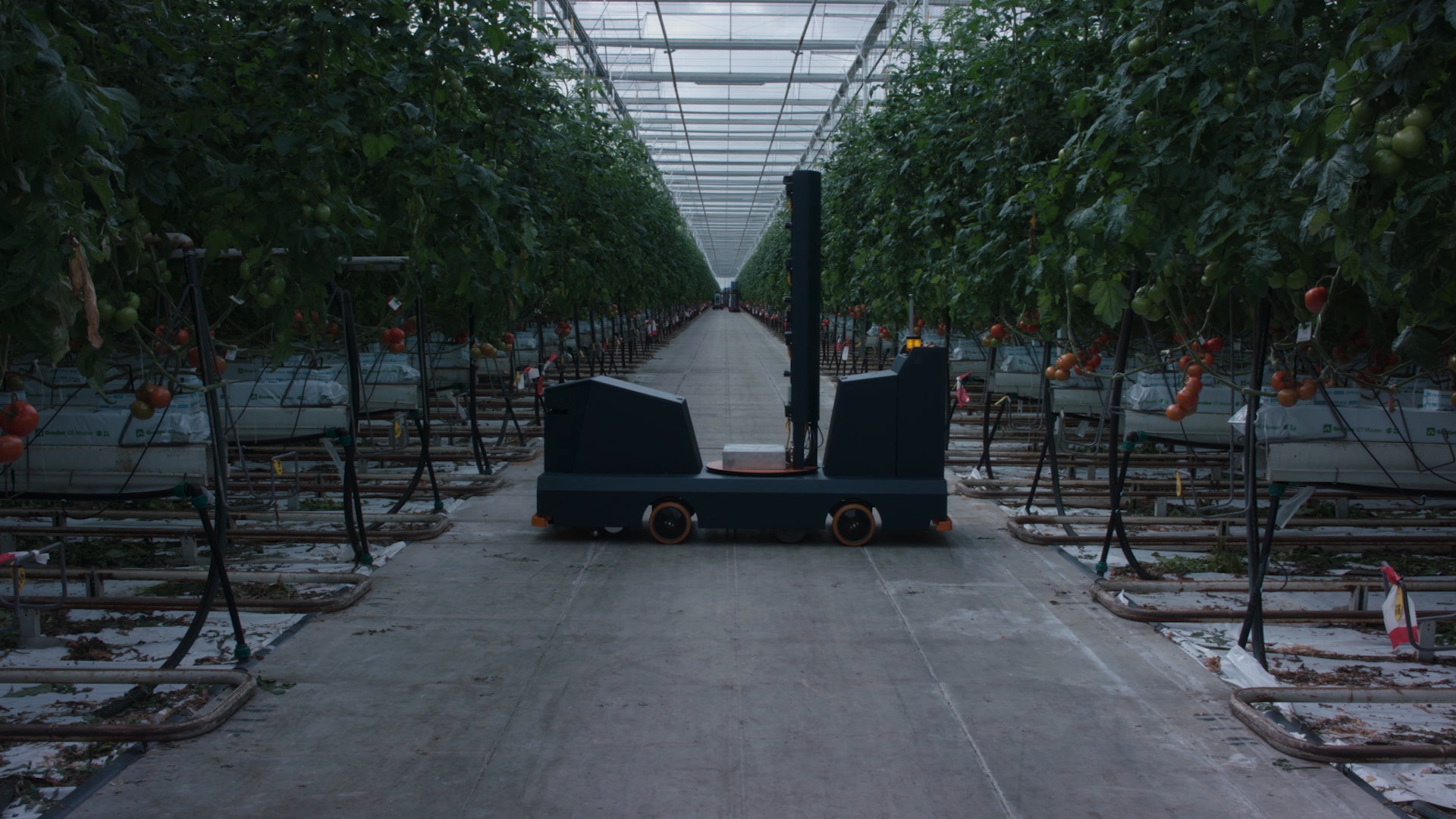
Still from the film Agrilogística (2021).
Yes, and you unfold another layer of this gaze through your filmmaking… where the camera is a kind of mediator of these perceptual thresholds between human-animal-plant whilst also being an instrument in the very sinister ‘production of truth’ in food production and marketing. On that note, you just opened your solo show Agrilogística at La Capella in Barcelona (congrats!) which orbits around these ideas of automation and imaging technologies in the context of industrial agriculture, can you speak a bit about the exhibition?
Thank you! I still can’t believe the show is on, after such a crazy year, it seems like a miracle.
In March 2019 I did a field trip to Westland, a region in The Netherlands with one of the largest high-tech agricultural and horticultural clusters in Europe, as part of the shooting for Agrilogística. The point of departure of the project was an unresolved intuition, a pending question deriving from on-going research: can contemporary greenhouses be conceived as machinic architectures in which more-than-human entities —animals and plants, but also robotic arms, ag-plastics, lights, cameras, sensors, irrigation systems— form a complex eco-technological mesh? And perhaps a much more daring question stemming from the previous one: if so, can a greenhouse be understood as a cinematic device where image production becomes indistinguishable from agricultural production?
I started to use my camera as a sensor among sensors, an idea that I’ve recently been discussing with Krista Lynes, after her article on “new greenhouse effects”. I filmed the Plantalyzer, an autonomous vehicle equipped with 6 stereoscopic cameras that capture thousands of images of tomatoes, producing datasets that are sent to a central computer that regulates the growth of vegetables. Each tomato produces an image that somehow feeds back into it, affecting its own growth. And it is an image that is not meant to reach the human eye, it’s meant to increase and streamline production. Jason Moore talks about the double-internality —of “capitalism in nature and nature in capitalism, of technology in nature and nature in technology.” These dialectical “bundles” resonated with almost every greenhouse I visited. I started to think about and with images that could render visible such double-internal logics, that could show how the tomato and the data-harvesting are co-engineered to become part of the same process. Thus, the film observes the intensive work carried out inside these contemporary agro-factories in which, far from an ecotopia of singularity, automation still relies on the precarious labor of migrant seasonal workers.
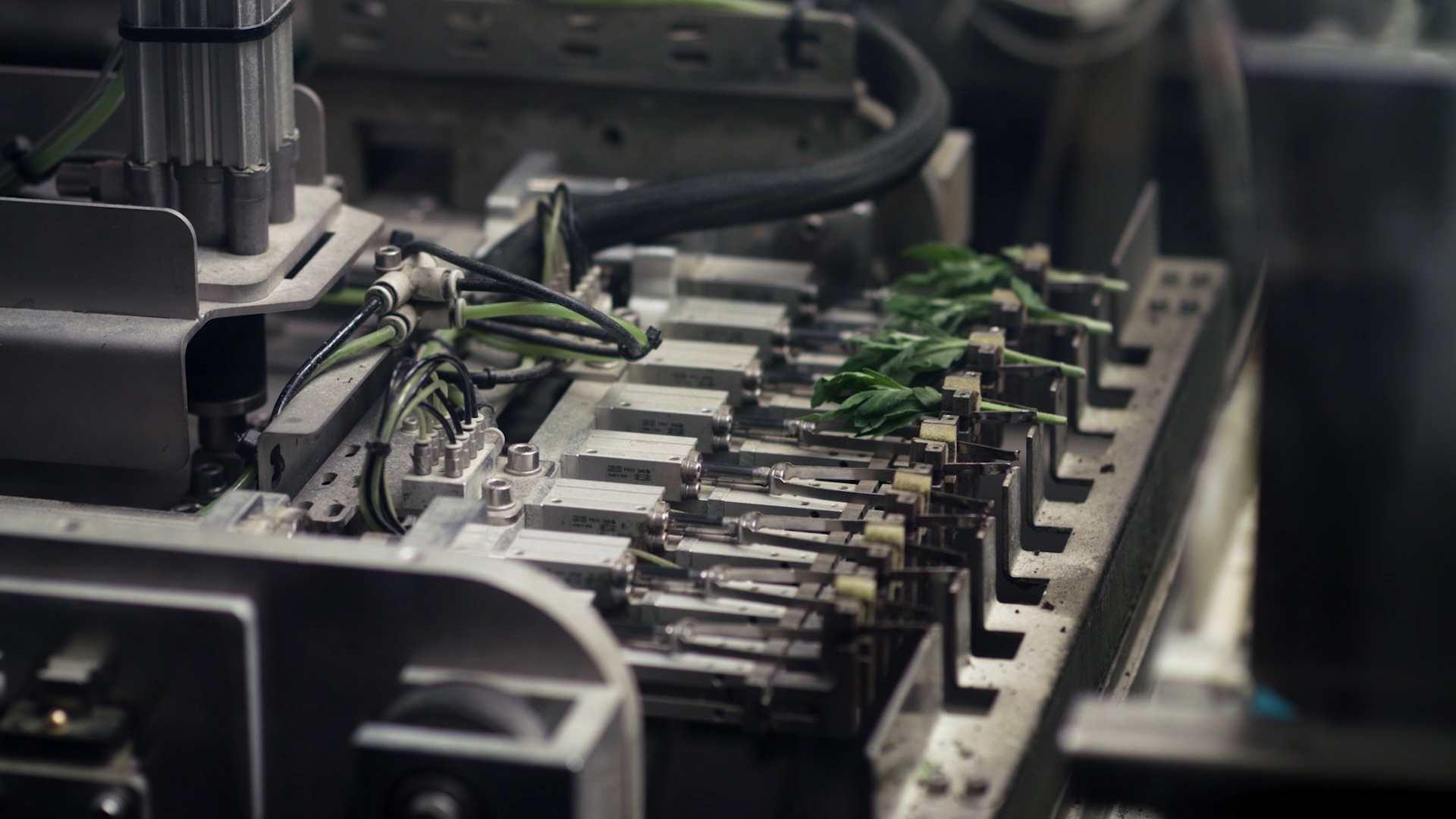
Still from the film Agrilogística (2021).
Outside some of these factories, there are animals in fenced areas, chickens, cows, sheep, and alpacas, that seem to provide an attraction for visitors and clients. During those intense days of shooting I had a dream: at night, these animals would break into the greenhouse and start exploring the space, eating the vegetables, interacting with the machines, entangling with the plants, wandering around, etc. It was an oneiric image that was somehow challenging the purity and sterility of the greenhouses, disrupting the sealed atmosphere where energy inputs and outputs are strictly controlled. The dream forced me to stop the production of the film for more than two years, where I’ve been trying to figure out how to shoot this fictional sequence with animals. I finally managed to do it, and it’s part of the current installation.
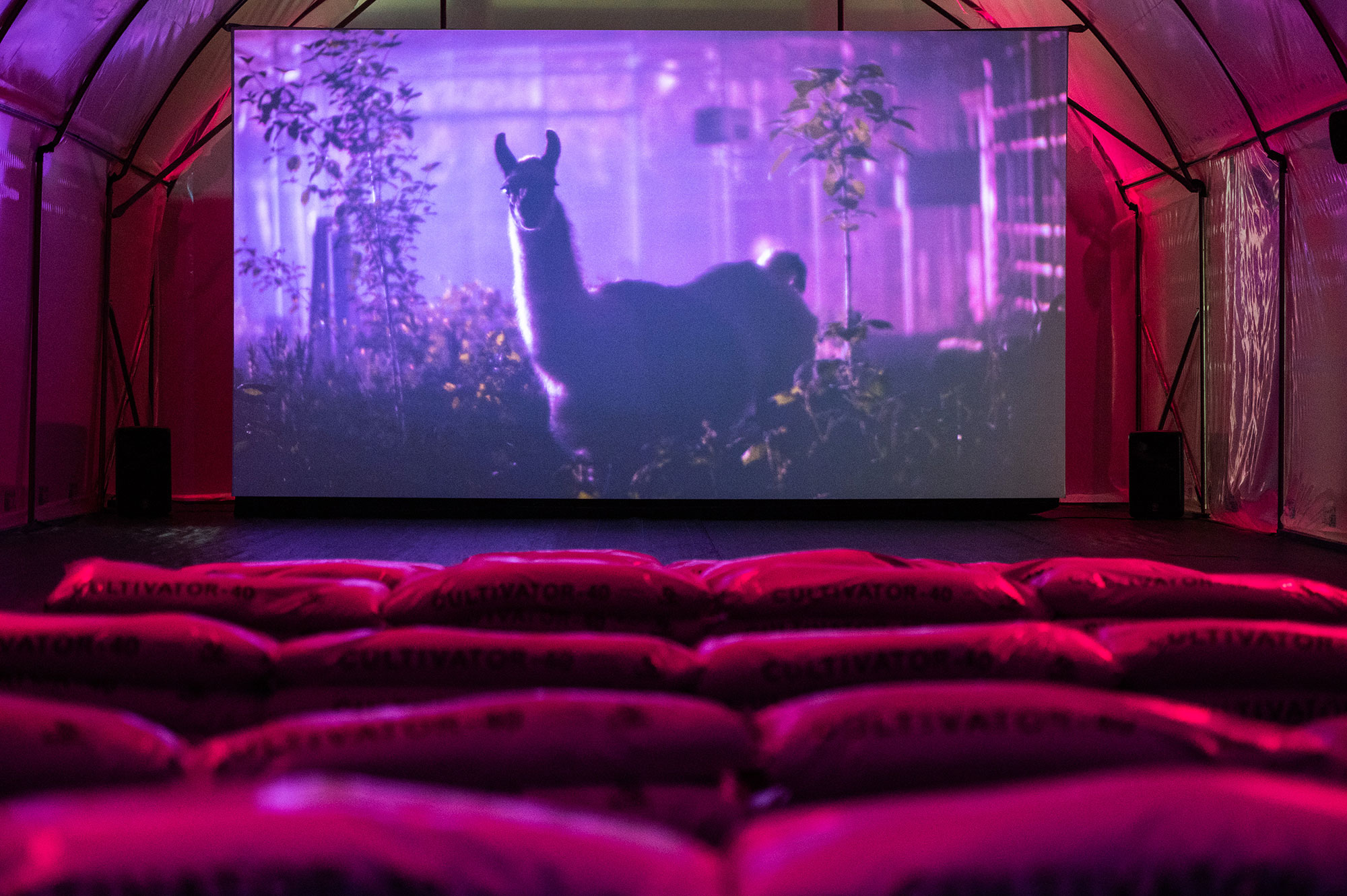
Installation view: Agrilogística at La Capella, Barcelona (2021). Photographs by Pep Herrero.
I’ve been working with Goig (Pol Esteve and Miquel Mariné) to experiment with some of these ideas and translate them in the exhibition space of La Capella, a former chapel from the XV century located in Raval, in the historic centre of Barcelona. We have installed a large polytunnel that occupies the central space of the chapel and imposes a particular circulation to the visitors. The result is a sort of a “synthetic chapel” - a meta-greenhouse that is also an incredibly cinematic display where images, light and sound reflect and morph in unexpected ways. I have been planning it remotely with Pol and Miquel and all the production team, but it wasn’t until we were physically installing it that I realized how it radically changed the experience of watching the film.
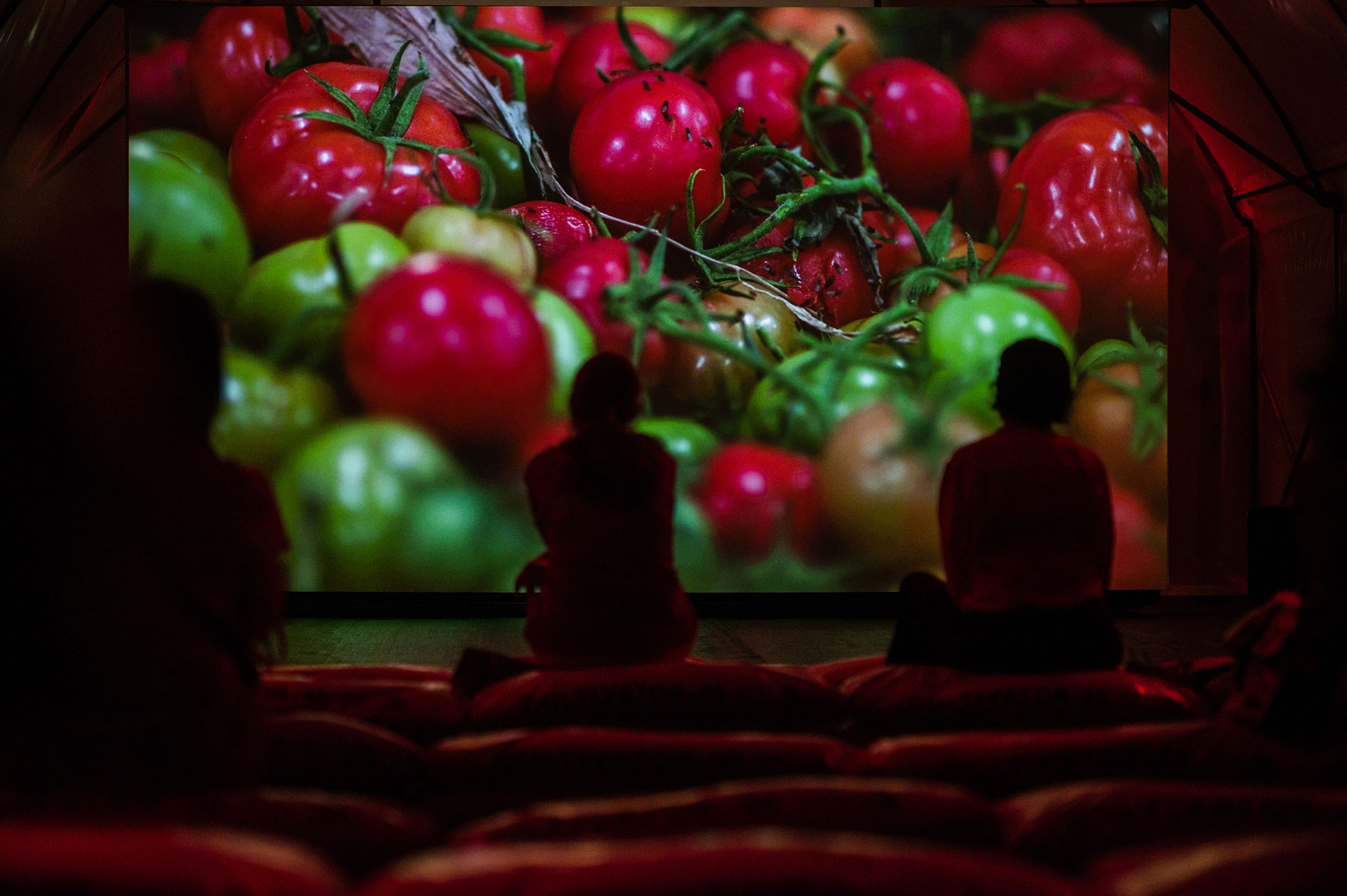
Installation view: Agrilogística at La Capella, Barcelona (2021). Photographs by Pep Herrero.
That sounds amazing, a very full-bodied experience of watching. And I like that as a viewer you are also intruding into this hermetic space, contaminating temperatures and air quality... I wish I could see it! Just to wrap up, have you got any other projects planned for this year?
Thanks! I’m sure there will be an occasion to show the project in the UK.
I’m currently working on a series of video capsules commissioned by Maria Puig de la Bellacasa (Warwick University) and Dimitris Papadopoulos (University of Nottingham), around the topic of Ecological Reparation. We have been interviewing researchers from a large range of disciplines to reflect upon notions of repair, remediation, and resurgence in social and environmental conflict. We will launch a Youtube channel next September and we are planning to publish around 35 interviews. It’s been intense and challenging but working with Maria and Dimitris has been an absolute pleasure, and an incredibly stimulating learning process.
I have also recently received financial support to complete my PhD at Goldsmiths under the supervision of Ros Gray and Wood Roberdeau at the Art Department. My doctoral project will probably occupy most of my time in the next two years. My current research investigates the technologies and ecologies of food production, distribution and consumption. Agrilogística has focused on aspects related to “production” and Future Foods is based on a case study around “consumption”. My aim is to develop a new work around “distribution”, for which I started looking at a new case study, observing the proliferation of Dark Kitchens during the pandemic, the emergence of the so-called Data Gaze and the circulation of food within the platform economy. Projects always evolve and can drastically mutate so this is just a point of departure... let’s see where it leads.
In parallel, there are a few exciting exhibitions I’ve been invited to take part in like Potential Agrarianisms curated by Maja and Reuben Fowkes at Kunsthalle Bratislava, and the London Open 2022 at the Whitechapel. Let’s hope that things start to open up again and we can go back to cinemas, exhibitions, universities and see each other again. Massive thanks for inviting me to have this conversation. I’m sure we will continue to cross paths in the future!
__
Agrilogística is on at La Capella until 5th September 2021
gerardortin.com
lauraplant.co.uk
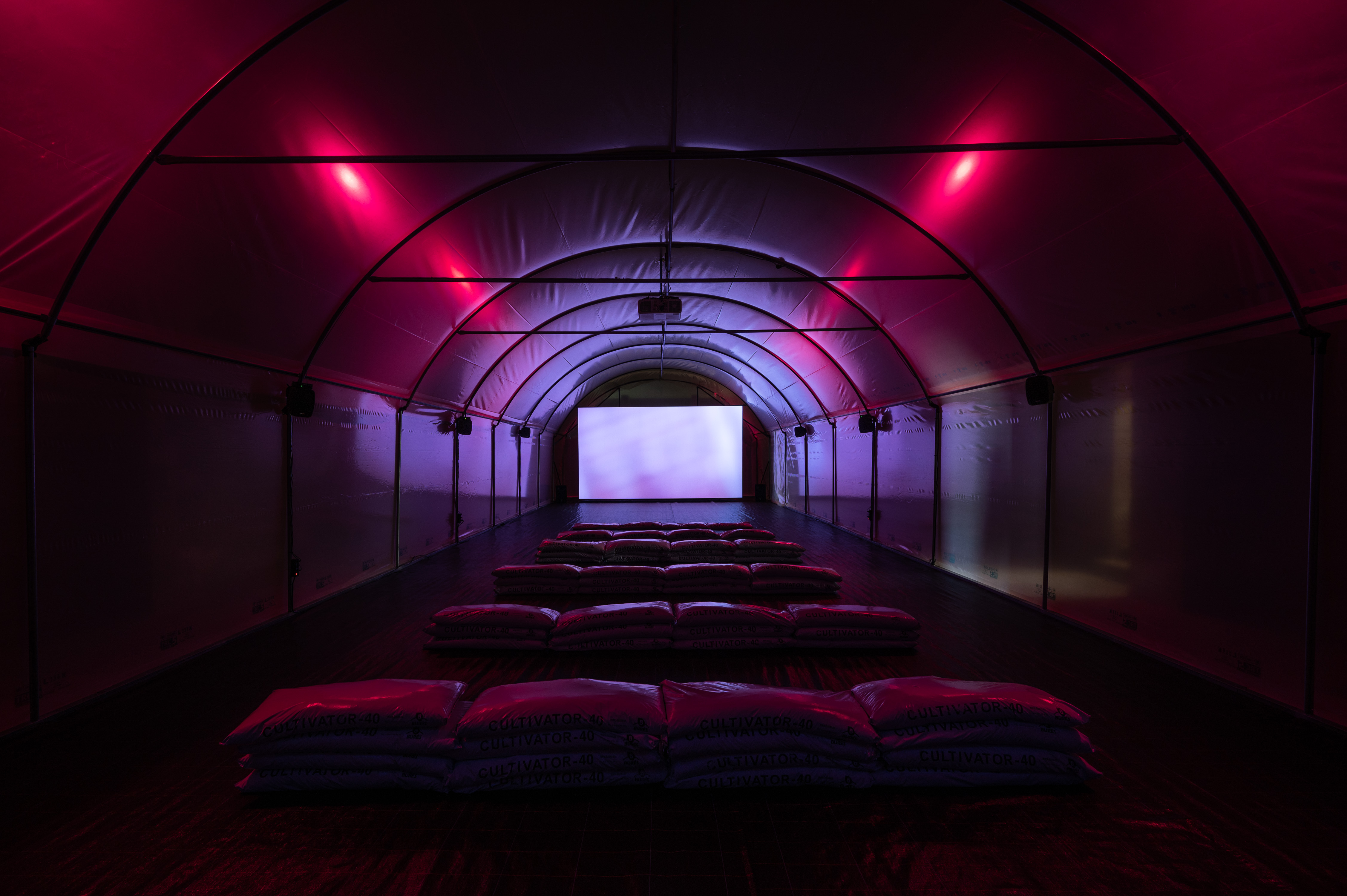
Installation view: Agrilogística at La Capella, Barcelona (2021). Photographs by Pep Herrero.
-
If you like this why not read our interview with Kara Chin & Harley Kuyck-Cohen.
-
© YAC | Young Artists in Conversation ALL RIGHTS RESERVED
